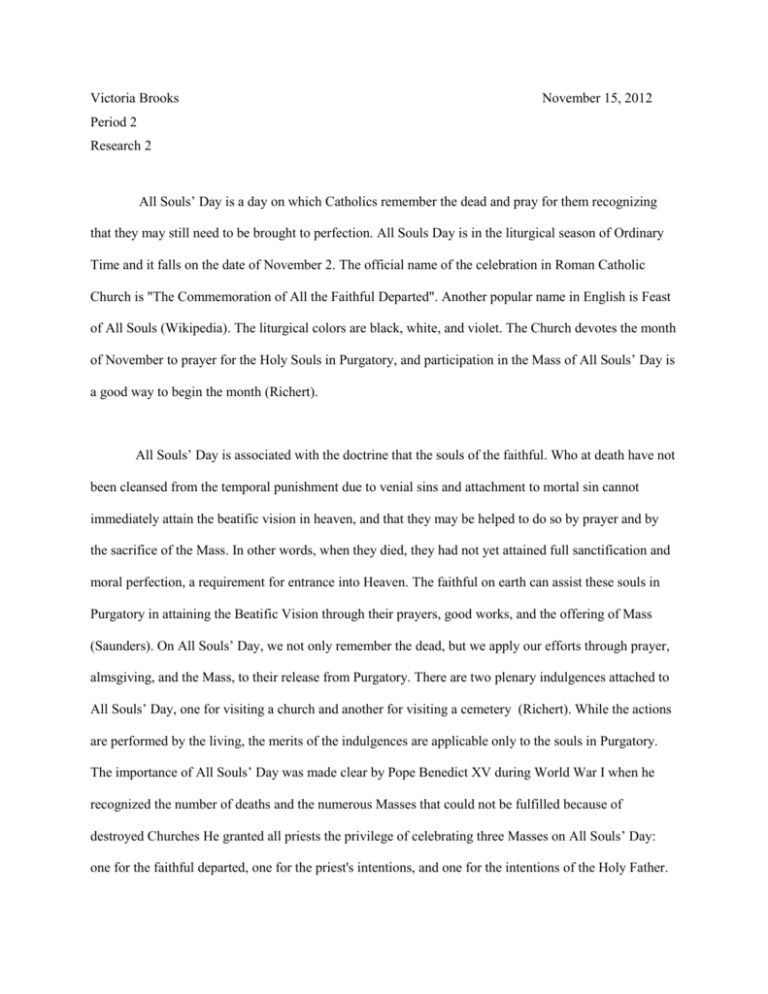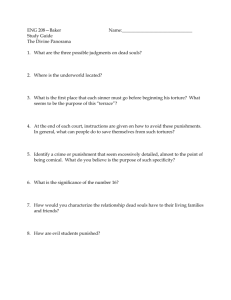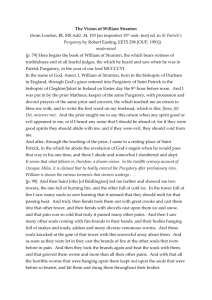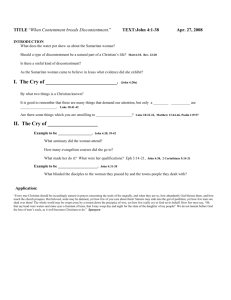Research 2 All Souls Day
advertisement

Victoria Brooks November 15, 2012 Period 2 Research 2 All Souls’ Day is a day on which Catholics remember the dead and pray for them recognizing that they may still need to be brought to perfection. All Souls Day is in the liturgical season of Ordinary Time and it falls on the date of November 2. The official name of the celebration in Roman Catholic Church is "The Commemoration of All the Faithful Departed". Another popular name in English is Feast of All Souls (Wikipedia). The liturgical colors are black, white, and violet. The Church devotes the month of November to prayer for the Holy Souls in Purgatory, and participation in the Mass of All Souls’ Day is a good way to begin the month (Richert). All Souls’ Day is associated with the doctrine that the souls of the faithful. Who at death have not been cleansed from the temporal punishment due to venial sins and attachment to mortal sin cannot immediately attain the beatific vision in heaven, and that they may be helped to do so by prayer and by the sacrifice of the Mass. In other words, when they died, they had not yet attained full sanctification and moral perfection, a requirement for entrance into Heaven. The faithful on earth can assist these souls in Purgatory in attaining the Beatific Vision through their prayers, good works, and the offering of Mass (Saunders). On All Souls’ Day, we not only remember the dead, but we apply our efforts through prayer, almsgiving, and the Mass, to their release from Purgatory. There are two plenary indulgences attached to All Souls’ Day, one for visiting a church and another for visiting a cemetery (Richert). While the actions are performed by the living, the merits of the indulgences are applicable only to the souls in Purgatory. The importance of All Souls’ Day was made clear by Pope Benedict XV during World War I when he recognized the number of deaths and the numerous Masses that could not be fulfilled because of destroyed Churches He granted all priests the privilege of celebrating three Masses on All Souls’ Day: one for the faithful departed, one for the priest's intentions, and one for the intentions of the Holy Father. The Feast of All Souls’ owes its beginning to seventh century monks who decided to offer the Mass on the day after Pentecost for their deceased community members. All Souls’ Days origins can be found in the writings of Saint Peter Damian, who in the tenth century tells of a Christian Hermit who lived near a cave. The hermit explained to a pilgrim that he could sometimes overhear demons in the cave complaining about all the souls that are released from purgatory through the prayers and sacrifices of the monks in Cluny, France. When the French pilgrim returned to France, he visited the monastery of Cluny and the abbot of the monastery to tell Abbot Odilo of the great number of souls delivered from purgatory through the humble prayers of the Cluniac monks (Marshall). The Benedictine monastery in Cluny chose to move their Mass for their dead to November 2, the day after the Feast of all Saints. This custom spread and in the thirteenth century, Rome put the feast on the calendar of the entire Church. The date remained November 2 so that all in the Communion of the Saints might be celebrated together. The liturgical colors of All Souls’ Day are black, white, and violet. Black represents sorrow and mourning (Bennett). White represents purity, joy, innocence. Violet symbolizes penance, humility, and melancholy. All Souls’ Day has other symbols such as the candle, incense, the skull, marigold, and the raven or crow. The skull is a sign which symbolizes death or rebirth. The Marigold is a traditional flower that is associated with the dead (All Souls' Day). Some say that the flower represents the rays of the sun, which is linked with life, so the deceased have not lost their place in the universe. The raven and the crow which both have been claimed as the true symbol associated with death. There is a candle placed for each dead soul, and they are adorned in some manner. Incense, mementos, and photos, are other remembrances of the dead. Many traditional Catholics still honor customs related to the relief of the souls suffering in purgatory. One custom is for one person to pray six Our Fathers, Hail Mary's and Glory Be's for the intentions of the Pope in a Church, and thereby, receive a plenary indulgence for a soul in purgatory. All Souls’ Day are rooted in Christian belief and arose in this life of the Church through a healthy spirituality. Praying for the dead is a Christian obligation (Richert). In my reflection I wonder how the atmosphere will be like and how will this make me feel in return. While the Feast of All Saints is a day to remember the glories of Heaven and those there, the Feast of All Souls reminds us of our obligations to live holy lives and that there will be purification of the souls of those destined for Heaven. Works Cited 123holiday.net. All Souls' Day. <http://all-souls-day.123holiday.net/>. Bennett, David. What Is All Souls Day (Commemoration of the Faithful Departed)? September 11, 2012 <http://www.churchyear.net/allsouls.html>. Marshall, Dr. Taylor. "The Origin of All Souls day...Voices from a Volcano." 2010. Richert, Scott P. About.com <http://catholicism.about.com/od/holydaysandholidays/p/All_Souls_Day.htm>. Saunders, Rev. William. All Saints and All Souls <http://www.catholiceducation.org/articles/religion/re0199.html>. Wikipedia. 6 January 2013. <http://en.wikipedia.org/wiki/All_Souls'_Day>.





